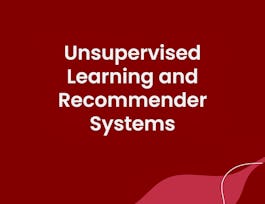In this course, you will see how to use advanced machine-learning techniques to build more sophisticated recommender systems. Machine Learning is able to provide recommendations and make better predictions, by taking advantage of historical opinions from users and building up the model automatically, without the need for you to think about all the details of the model.



Advanced Recommender Systems

Instructor: Paolo Cremonesi
Sponsored by MAHE Manipal
3,437 already enrolled
(23 reviews)
Recommended experience
What you'll learn
You will be able to use some machine learning techniques in order to build more sophisticated recommender systems.
You will learn how to combine different basic approaches into a hybrid recommender system, in order to improve the quality of recommendations.
You will know how to integrate different kinds of side information (about content or context) in a recommender system.
You'll learn how to use factorization machines and represent the input data, mixing together different kinds of filtering techniques.
Details to know

Add to your LinkedIn profile
4 assignments
See how employees at top companies are mastering in-demand skills


Earn a career certificate
Add this credential to your LinkedIn profile, resume, or CV
Share it on social media and in your performance review

There are 5 modules in this course
In this first module, we will see how to apply machine learning to collaborative filtering techniques. We will learn how to write an item-based collaborative algorithm which is able to automatically learn the best similarities between items, in order to provide improved recommendations that better match the user opinions predicted by the model with the true user opinions. We will also understand how to train collaborative filtering algorithms that minimize this gap. We will finally define a new error metric based on ranking comparisons, useful to design learning-to-rank algorithms.
What's included
7 videos2 readings1 assignment2 peer reviews
In this second module, we will study a new family of collaborative filtering techniques based on dimensionality reduction and matrix factorization approaches, all inspired by SVD (Singular Value Decomposition). We will see the difference between memory-based and model-based recommender systems, discussing their limitations and advantages. In particular, we will learn how to turn basic matrix factorization algorithms from memory-based into model-based approaches. We will also analyse a new important parameter, the number of latent features. We will learn how to choose the correct number of latent features in order to provide personalised recommendations and to reduce the risk of overfitting historical data.
What's included
8 videos1 assignment1 peer review1 discussion prompt
In this third module, we will see how to combine two or more basic algorithms, such as collaborative filtering and content-based techniques, into a hybrid recommender system, in order improve the quality recommendations. We will study different hybridization approaches, from the simplest heuristic-based, to the more sophisticated machine learning-based. Thanks to hybrid techniques, we will be able to enrich the input of a collaborative recommender system with either content or contextual information.
What's included
10 videos1 assignment1 peer review2 discussion prompts
In this fourth and last module, we will introduce a new advanced technique of collaborative filtering with side information, which is called Factorization Machine (FM), and we’ll see how the input data should be represented when using this technique. With only one mathematical model, based on how you build the input table, we will be able to create a simple matrix factorization algorithm or a sophisticated collaborative filtering algorithm with side information (context, attributes on items or attributes on users). We will also discuss benefits and critical issues of algorithms based on FMs. At the end of the module you will know how to use FMs to mix together different kinds of filtering techniques and how to balance different kinds of input information, playing with coefficients and weights, in order to make better and more sophisticated predictions.
What's included
7 videos1 assignment1 peer review1 discussion prompt
The RecSys Challenge is the best way to train your competences: it's a practical exercise which provides a "hands-on" opportunity to put to good use and improve what you've been learning during this course (learning by doing). The application domain is an online store, the dataset we provide contains 4 months of transactions collected from an online supermarket. The main goal of the competition is to discover which item a user will interact with. The RecSys Challenge is optional and it is not required to pass the course. If you complete it, you will receive an Honors designation on your Course certificate.
What's included
1 reading1 programming assignment
Instructor

Why people choose Coursera for their career




Learner reviews
23 reviews
- 5 stars
56.52%
- 4 stars
13.04%
- 3 stars
0%
- 2 stars
13.04%
- 1 star
17.39%
Showing 3 of 23
Reviewed on Jun 24, 2021
Great course to overview advanced techniques to build recommender system.
Recommended if you're interested in Data Science

DeepLearning.AI

University of Washington

Open new doors with Coursera Plus
Unlimited access to 10,000+ world-class courses, hands-on projects, and job-ready certificate programs - all included in your subscription
Advance your career with an online degree
Earn a degree from world-class universities - 100% online
Join over 3,400 global companies that choose Coursera for Business
Upskill your employees to excel in the digital economy






